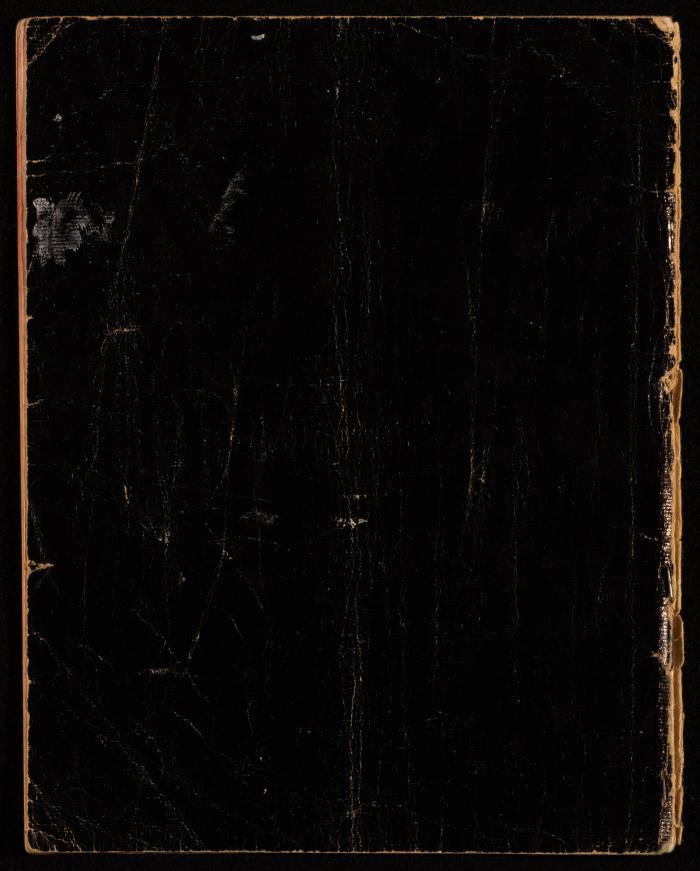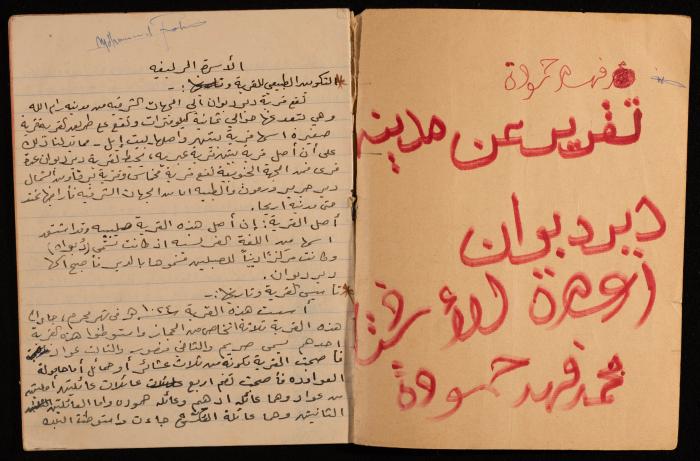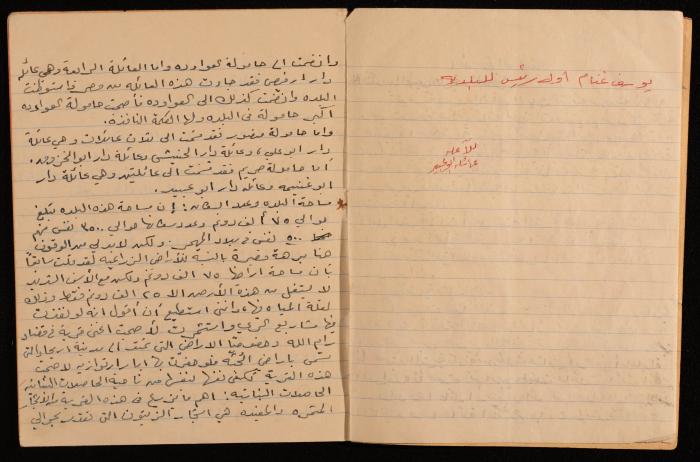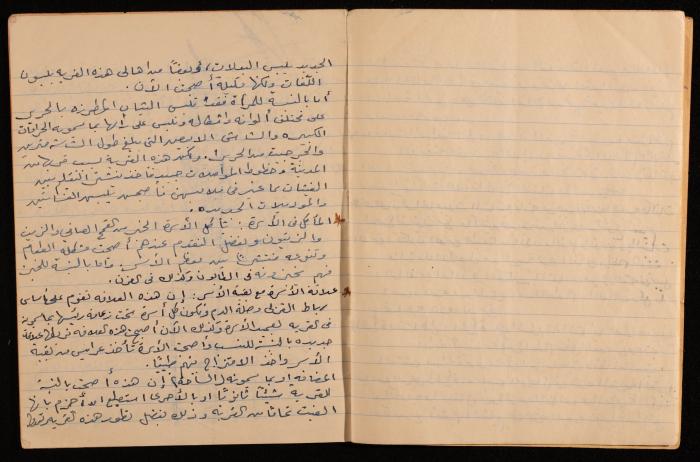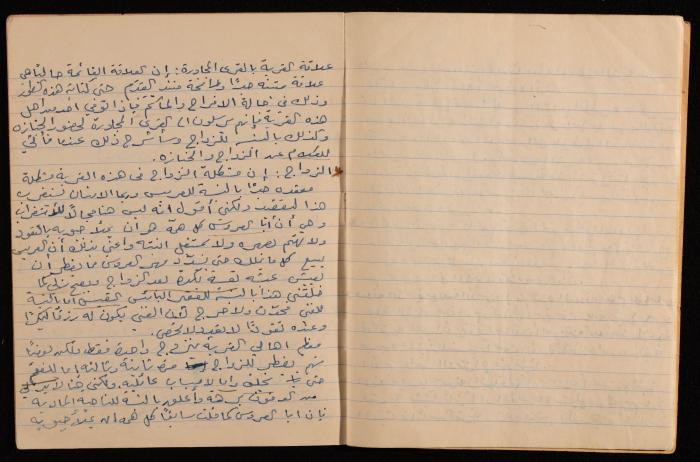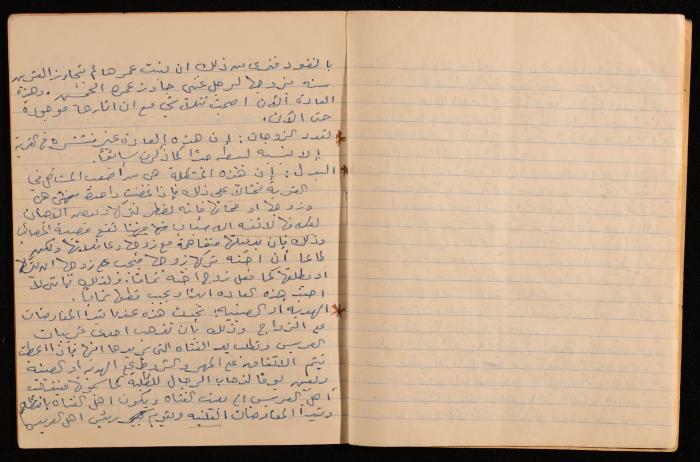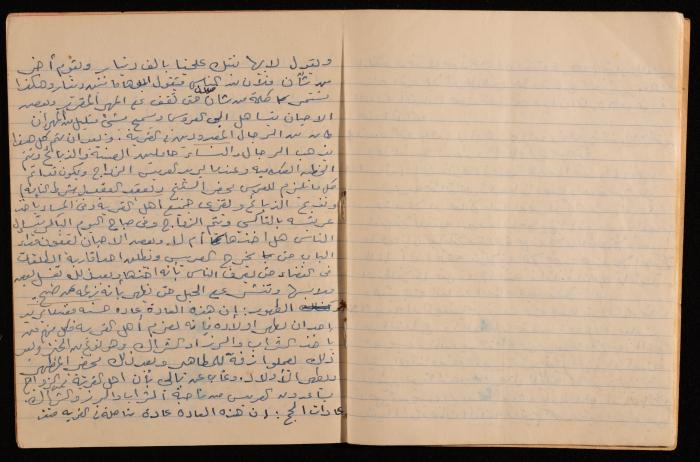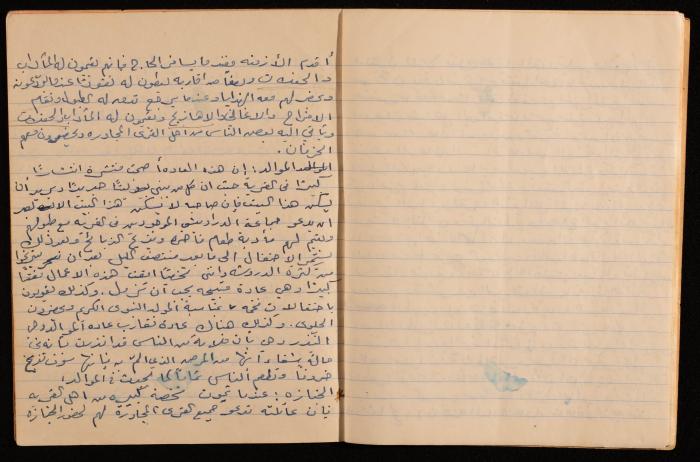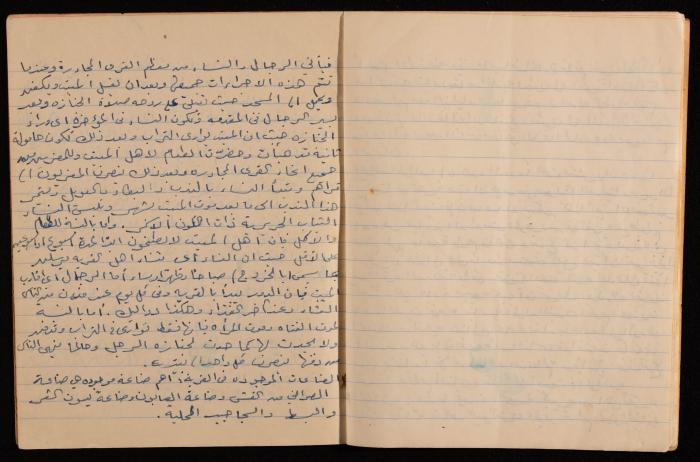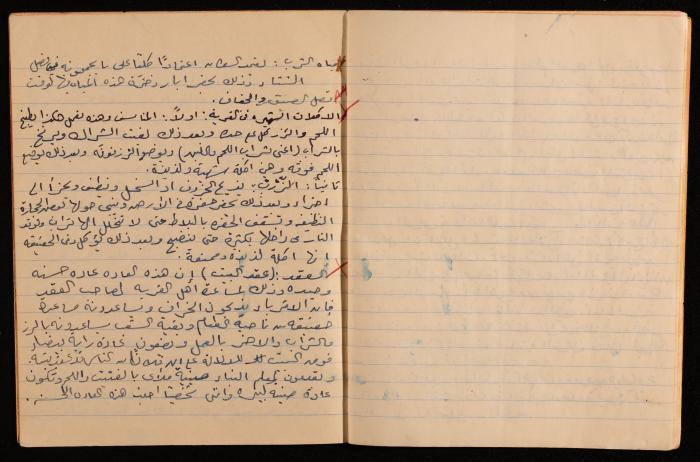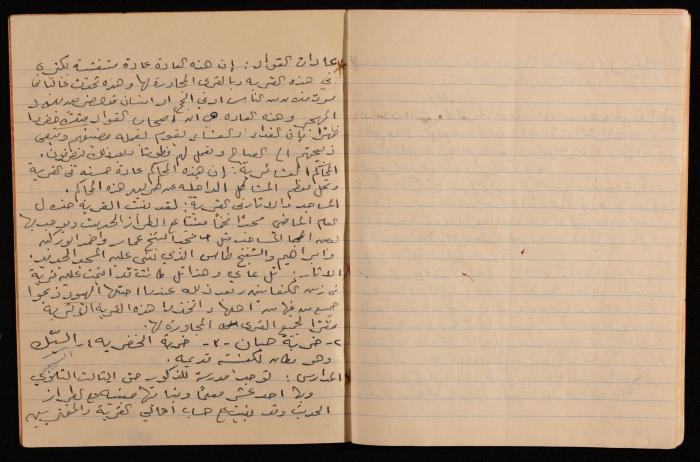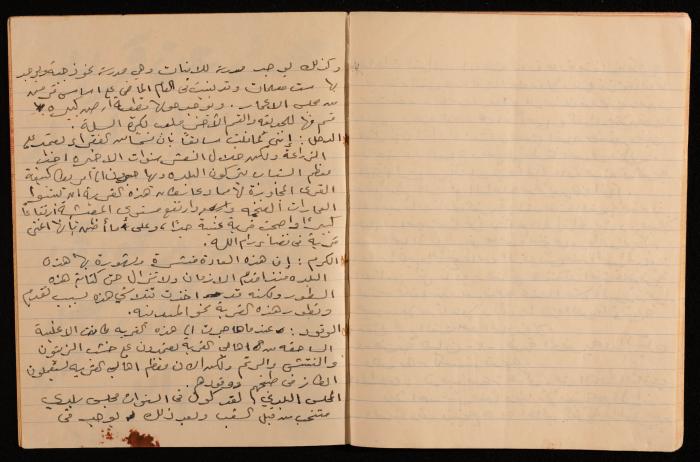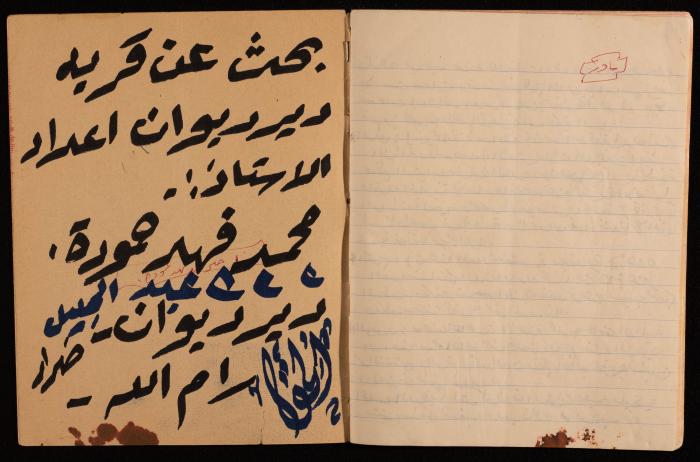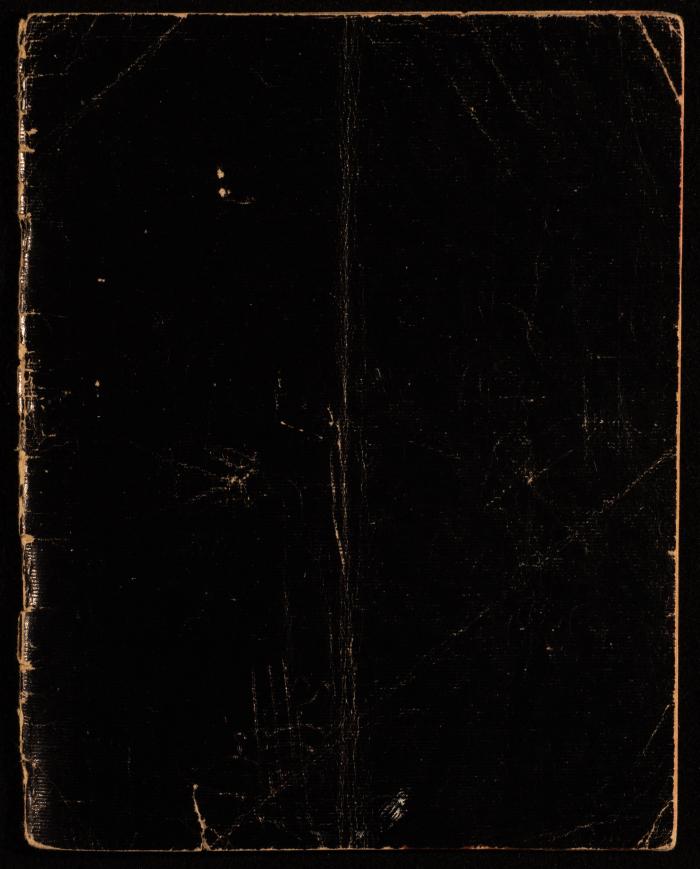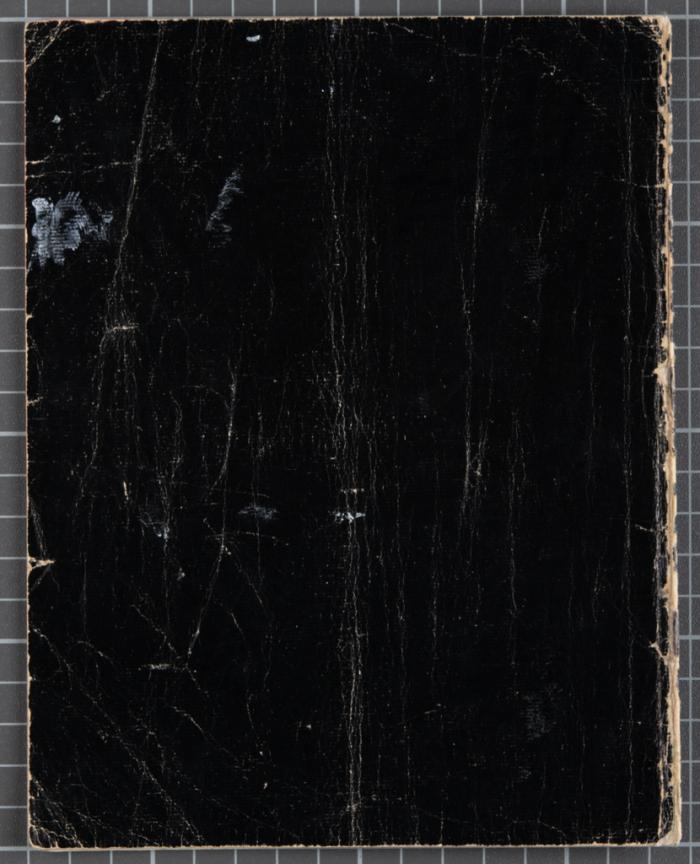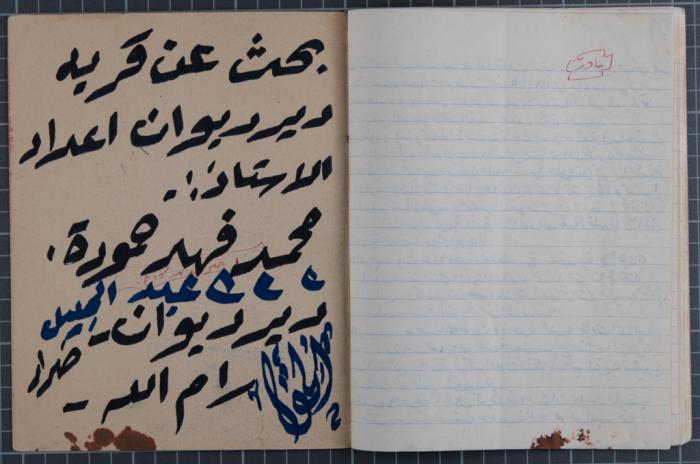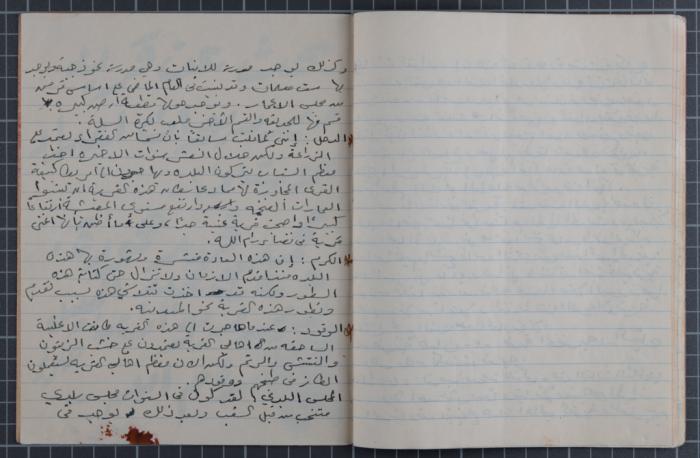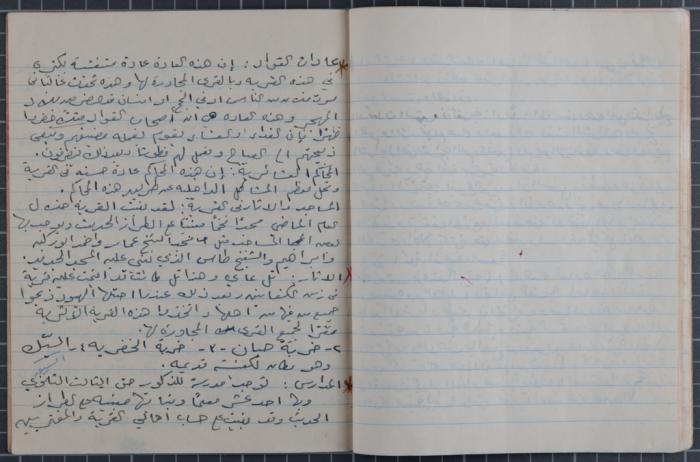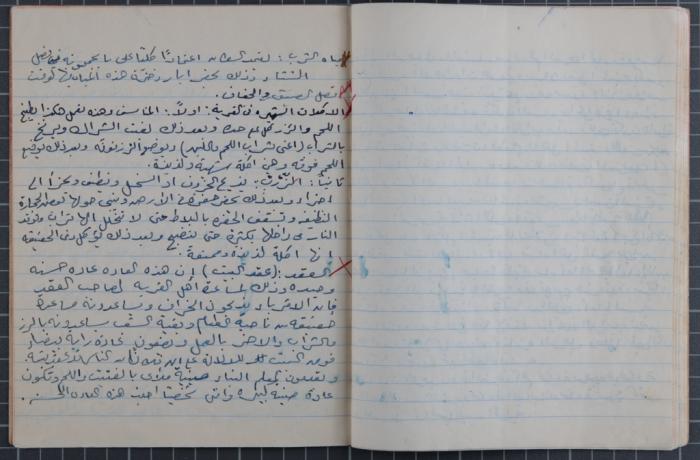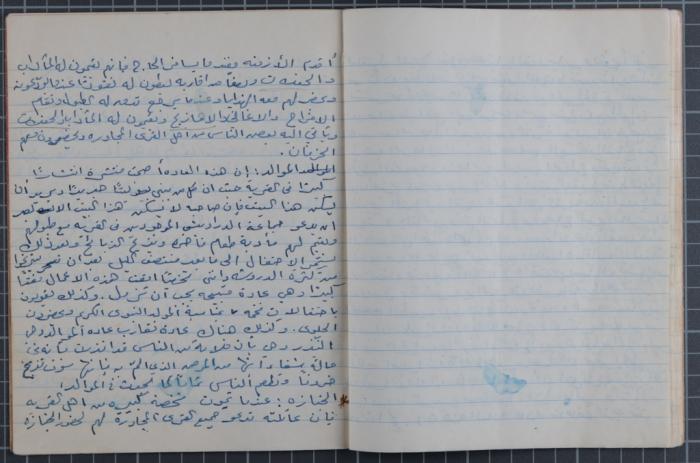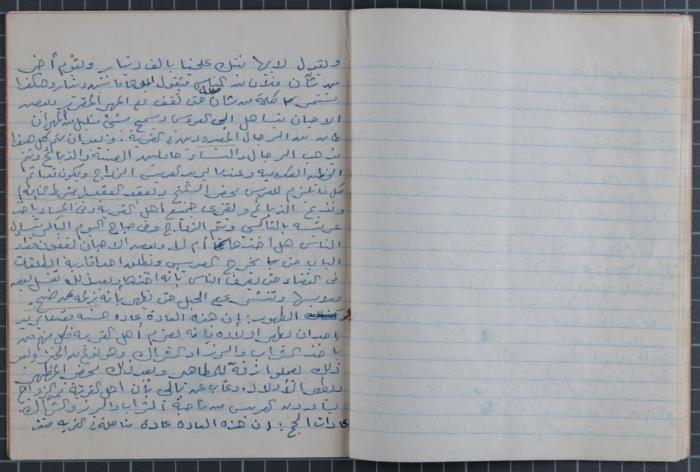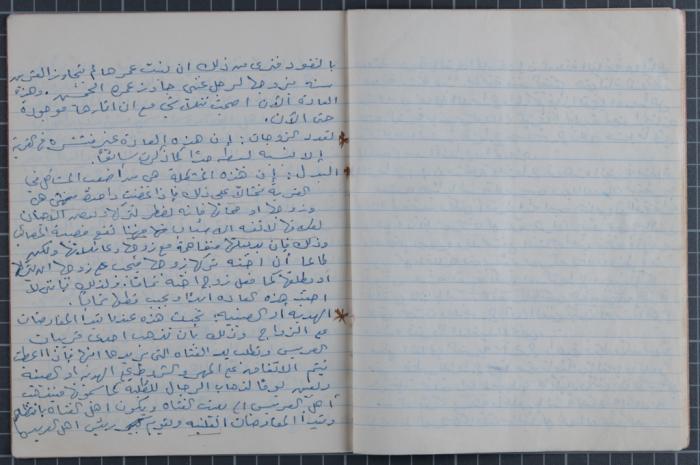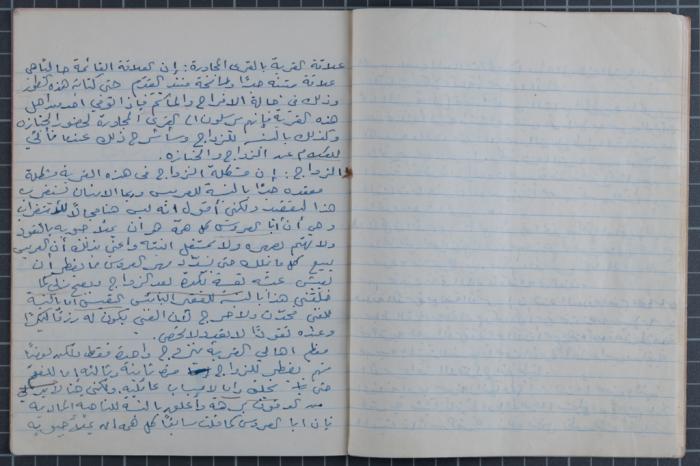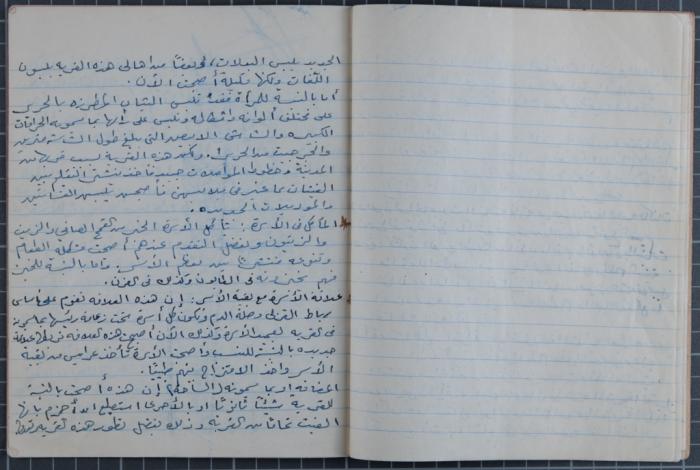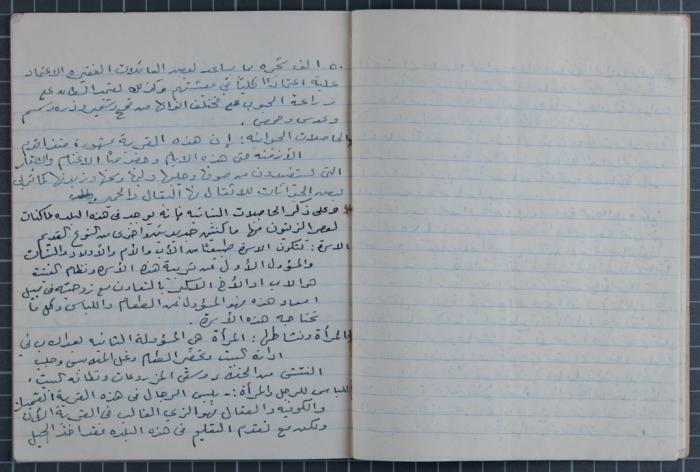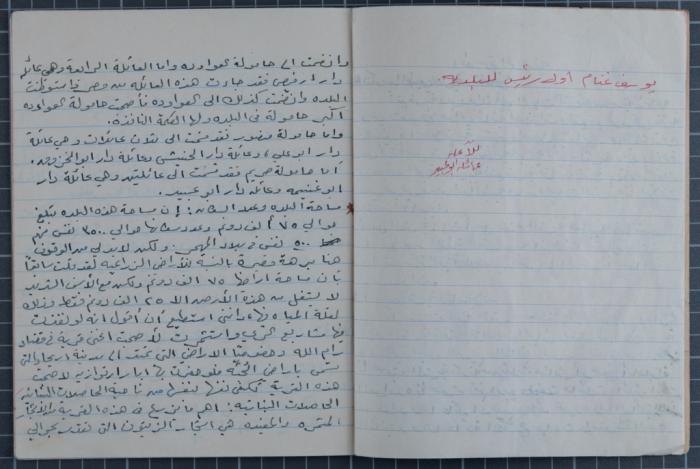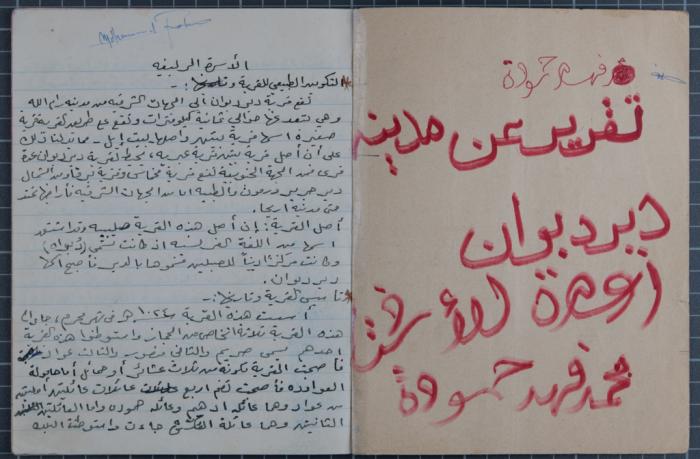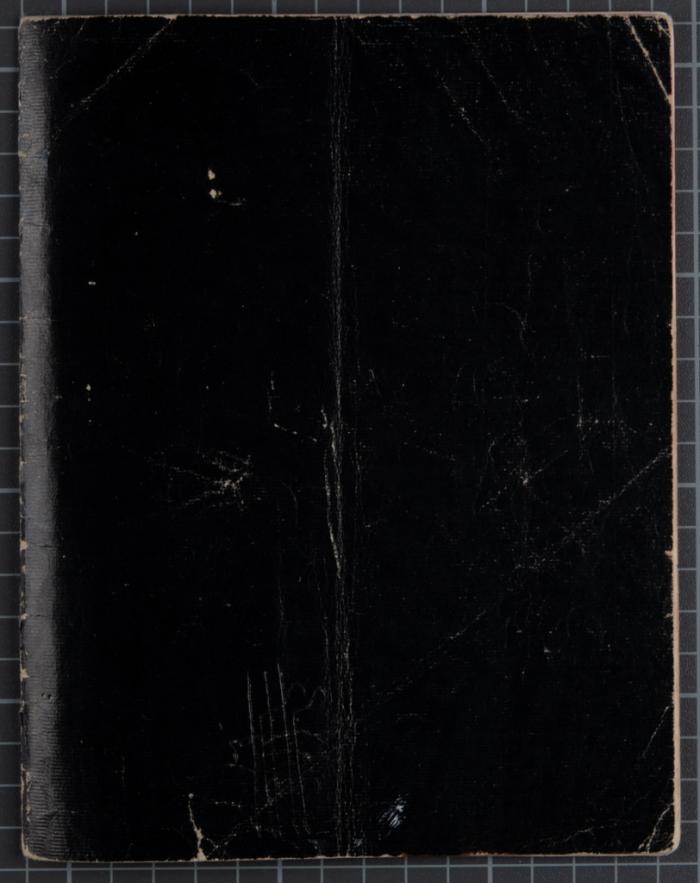A Report on the Town of Dayr Dibwan, Muhammad Hammoudeh, the Late 1950s and Early 1960s
Handwritten in Arabic, this document shows a report by Mohammad Fahed Hamoudeh during the late 1950s and early 1960s on the town of Dayr Dibwan located in the Northern-East of the city of Ramallah. The 15-page report demonstrates the social history characteristics of the town of Dayr Dibwan and tracks down the origins of its families since (1024) Hijri (1615-1616) AD. It is worth mentioning that Dayr Dibwan consists of about 72,000 dunums with a population of 3000 -at the time of writing- and 500 were in diaspora, while Yousef Ghannam was the first Mayor of the town. This report takes into consideration both financial and social habits of the town citizens their professions during this documentation, in addition to the nature of activities conducted by men and women, style of living in the countryside, and the traditional clothing such as the “Qumbaz, Kufiya and Agal”, which most men wore, while women wore embroidered silk thobes. On the other hand, the new generation of men wore suits and due to the close geographical distance to the city, transportation and the widespread of education among girls, women wore dresses and modern garments. Farmers of Dayr Dibwan have intensively taken advantage of only 25, 000 dunums for agricultural purposes due to the scarcity of water. It also mentions that olive trees were of the most important crops, at approximately 50.000 trees, which poor families depended on in their livelihoods along with other kinds of seeds, where the writer explained that there were 2 modern olive mills and a vintage one. The report mentions the livestock and Dayr Dibwan being known for raising sheep and cows to use their meat, wool and milk, and other weight lifting animals. Families of Dayr Dibwan naturally consisted of the father, mother, and their children and either the father or the elder brother is considered the one responsible for fulfilling the duties of the family along with his wife, women, on the other hand, were considered to be second to their husbands in responsibility besides their work in tidying, cleaning and making food in the house. Regarding food, families would eat bread made with pure wheat and olive oil, baked in the Taboon or ovens, before food became varied and widespread due to progress. When it comes to the structure of families, the report shows that it was usual for them to be headed by the chief, while relationships between families were based upon blood before they sprouted into relations of marriage and the natural integration amongst them. According to the writer, “al-Madafah”, or “the yard”, where families would gather became secondary due to the development and progress of the town, while the town’s relationship with neighbouring villages is still strong and rooted into the years and that they still exchange visits during happy and sad occasions until the writing of these lines. The report also discusses marriage and sees it as a complicated matter, considering that lately, all the father of the bride could think of is to fill his pockets with money without caring about the consequences of hitting his daughter and son in law in the future, as a result of the groom having to sell everything he owns to pay for the dowry and wedding, moreover, the father would marry off his daughter who is not twenty years of age yet to a man beyond his fifties out of greed for his money, pointing out that this habit is dying out but its social effects remain. The report also suggests that most of the town’s people were satisfied with one wife, but some would have to marry a second or a third for familial reasons or reasons connected to infertility. He also discusses the habit of “exchange”, where a man would marry off his sister or female relative to a man, who in turn would do the same thing, as in marrying off his female relative to the first man as a sort of marital exchange, while the report considers this habit to cause some of the worst issues in Dayr Dibwan, where if one of the men fought with his wife and wanted to divorce her, the second man would divorce his wife even if he was on good terms with his wife, as an answer to the divorce of her “exchange”. The report sheds light on many social habits and behaviours during seasons and occasions including the engagement, which begins when a female relative of the groom visits the bride’s family and discusses the matter privately, if an agreement regarding the conditions and dowry is reached, men begin to publicly negotiate the dowry and raise it for the honour of certain persons and the father of the bride might decrease it slightly if the husband is one of the few men of the village. After they are in agreement, the wedding occurs, sheep are sacrificed, and food is made for the village people and in the morning after the wedding, the groom meets his relatives who celebrate him by firing shotguns. Another habit mentioned in the report is “Tuhur” or the circumcision of boys, pointed out as a good habit, where the village people are invited to lunch while the boys who will be circumcised are carried in a “Zaffeh”, after which the “Mutaher” the physician responsible for the circumcision comes to finish the job. The report moves on to speak of the habits connected to the Haj considering that they are rooted in the village, where they hold feasts and parties to the person before he leaves for Haj and some of his relatives would give him money as he leaves, while he brings them back gifts upon his return as his family throw parties and beat drums for him, as well as the oncoming convoy of congratulators and some of the neighbouring villages’ people bring his sheep as a gift. The conversation regarding customs and traditions continues as it discusses the celebration of Mawlids considering them spreading widely in the village, specifically when a villager moves into a new house, where he does not move until he invites the “Dervish people” to beat their drums as he sacrifices sheep, makes feasts and celebrates until after midnight, the writer of this report detests this custom and calls it an ugly custom that must be left forgotten. He also mentions that villagers would hold “luxurious” celebrations for the Mawlid and bring sweets, as well as another custom similar to the Mawlid regarding the fulfilment of vows and sacrificing sheep and feeding people if the vow comes true, unlike the custom of Mawlid. The report extends the description of the funerals rituals and their customs, where when a notable person in the village passes away, the neighbouring villagers are invited to the funeral, which is attended by men and women, as the deceased is carried to the mosque for prayer after being washed and shrouded, then the men would walk at the beginning of the funeral march and the women would follow, after the burial, another family prepares the food for the family of the deceased and those who offer condolences from other villages. After the funeral ends and people return to their villages, women start crying and lamenting for a month while wearing black silk clothes. The custom is that the family of the deceased does not cook for one or two weeks, where food gets sent to the women in the homes and men are invited to dine for this period of time at the house of a different villager every time. The report clarifies that these rituals used to be monopolized for the men who are deceased, where a deceased woman would be buried without any of these rituals, but people leave for their homes after the funeral. On the other hand, the report mentions that making straw trays was the most important activity in the village, in addition to soap making, tents and local rugs. It also mentions the residents digging wells to gather and store water during winter and using it during summer and hydration as they completely depended on it. The report points to the Mansaf, which is a dish containing meat, yoghurt, rice and broth (meat and yoghurt broth) ad to the Zarb, which is a dish where meat is cooked by burying it into a hole and lighting it on fire for long periods of time, and these two dishes are considered to be the most famous in the village. Another custom pointed out by the report as a fine custom is “Aqd” or “house Aqd”, which is finishing the construction of the house roof, where villagers offer to help the homeowner as some of his relatives sacrifice sheep and help him with food, and the rest of them would offer rice and broth or help with finishing up the work, usually, a white flag is held on top of the house to signify ending the construction of the roof, the report writer also mentions that they would specify the “construction chief” with a plate full of crumbs and meat. The report also mentions the custom of “Qowad” as widespread in Dayr Dibwan and surrounding villages, which is to be hospitable to guests, sacrificing sheep and making food on many occasions including death, Haj or returning from a trip. It also points out clan courts considering them a fine custom, where they aid in resolving most internal issues, as well as mentions that the village had witnessed the construction of a modern mosque in the year prior to writing this report, to be added to the already existing mosques such as “Sheikh Ammar Mosque” and “Shaikh Tas Mosque”, where the new mosque is built. The report moves on to mention that the village has remnants and ruins including the area of “Tel Adi”, which witnessed the building of a village during the Canaanites era, which Israel occupied, massacred the people and made the archaeological site a (command) centre for all neighbouring villages. Dayr Dibwan has many ruins “Khirab” including Khirbet Hayyan, Khirbet al-Khudreyyeh and as-Siq, which is the site of an old church. In the department of education, the report mentions that in the village, there is a boys’ school modernly built, has 11 teachers and has classes up until the third secondary grade. This school was built with the financial aid of the villagers living inside and out. There is also a girls’ school, built the year prior to writing this report on the basis of a loan from the Palestinian Economic Council for Development and Restoration (PECDAR), has six teachers and is surrounded by a big block of land of which a piece was used as a park and another as a basketball court. The report mentions that a section of poor people acquired their livelihoods and depended on farming, but most of the youth immigrated during the last ten years (prior to writing the report) to the United States of America (USA) along with other neighbouring villages, which raised the standard of living in the village and witnessed the construction of huge buildings that led to Dayr Dibwan being so rich as the report writer thought it was the richest village in Ramallah (it is worth mentioning that there are several literary works that revolve around the finances of immigrants, the impact of their remittances on the socio-economic changes and urban transformations that the villages and cities of the region have witnessed). It also points out the generosity that was widespread in the village and it was famous for it a long time ago and still is until the writing of these lines, but this custom is beginning to dissipate due to the development of Dayr Dibwan and its direction towards the city. The writer mentions that when he immigrated to Dayr Dibwan, he found most of the villagers depending on their fuel on olive tree wood, sarcopoterium and retama, but most people now use gas in cooking or as fuel, he moves on to talk about the existence of an elected municipal council in Day Dibwan, but the last line of this report was not finished, as the writer fell ill and couldn’t complete it until he passed away in 1980.
Date created
COLLECTIONS
Tags
Topics
TYPE
LOCATION
More details
Format
Notebooks
Source of Description
Hamoudeh, Ghayda. “The Waleed Hamoudeh Collection”, Archival Inventory, 10 December 2020. The Palestinian Museum Digital Archive.
Help us refine the information, suggest a change in the content of this item
Suggest a Change
